There is a ridiculous number of humpback whales around, especially baby ones. I have never seen so many.
That’s saying a lot, as this year marks my 13th season photographing humpbacks in Tonga. Other people I trust who’ve been here a long time, like Allan, who owns Mounu Island Resort, and Brenda, who runs Endangered Encounters, have also made the same remark.
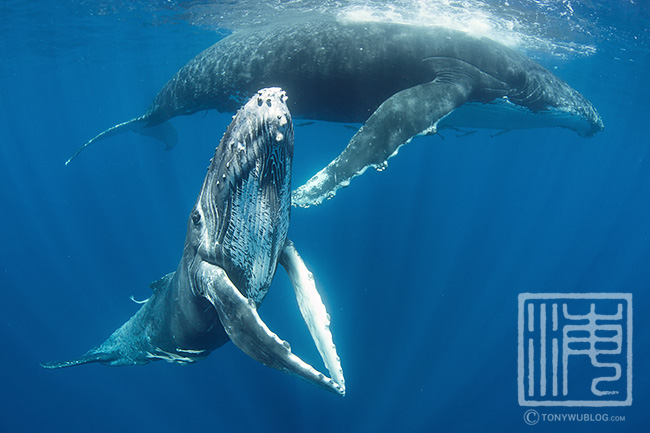
Here is some quantitive support.
At this point, I’ve spent 8.5 boat-days on the water (with a boat-day being approximately six hours at sea looking for humpback whales), during which I have photo-ID-ed 12 calves.
In 2012 (when my calf count ended with a record total of 52 babies), I had photo-ID-ed 7 calves after spending the same amount of time on the water.
Calculating a calf/ boat-day ratio to standardise for results per unit effort, right now I’m at 1.41, vs 0.82 for the same amount of time spent at sea in 2012 (I took it easy in 2013, so I can’t use that year for comparison).
There’s no way to know if this pace will continue, but to give you another indication of how many baby whales are here, there were at least 11 mother/ calf pairs in the inner waterways of the Vava’u island group last Friday (August 15th).
Eleven!!!
There are so many baby whales that it’s been impossible to leave the inner waterways to go look outside. We’ve tried several times to go to deeper water, but keep getting stopped by whale after whale, whale after whale, whale after whale. I have not yet made it beyond the channels and lagoons.
I never thought I could write this…but there are just too many whales!
Of course, the abundance a good thing, and I don’t honestly believe there are too many humpbacks here. It’s just been exhausting getting in-and-out of the cold water nonstop, plus sorting through and organising reams of photo and GPS data each night, then writing notes and backing up.
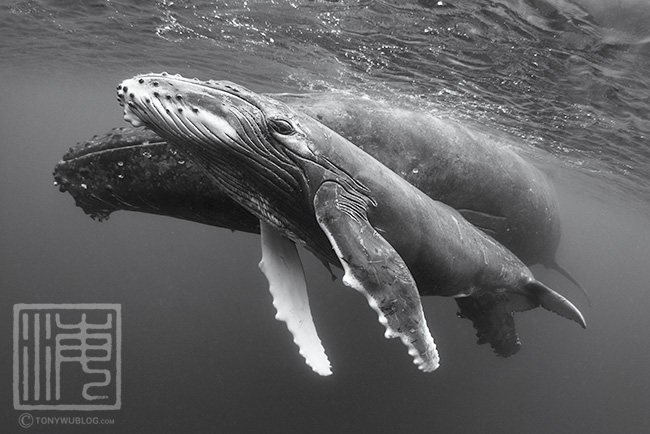
For reference, my total calf count right now is actually 14 unique babies, as Ma’ata, who is the guide at Mounu Island Resort, has sent me photos of two additional babies not among the 12 that I’ve ID-ed.
I know she has several more to send. Some may end up being repeats, but the way things are going this season, I’m almost certain there will be a few among the ones she’s photographed that I haven’t seen. (Thank you for your help Ma’ata!)
Also worth mentioning is that several of the mother/ calf pairs seem to be staying in the inner waterways of Vava’u for an extended period. My first encounter with calf 201404 and her mom, for instance, was on 8 August, and my most recent on 15 August, a span of eight days. I know they were around for a week or so before I went to sea, though I don’t have an exact date of absolute first contact.
My point is that many females with calves are sticking around, which has been the exception, rather than the rule, in previous seasons. Perhaps this is just a temporary blip and we’ll get reversion to the mean as the season progresses, but for now, it’s nice to be meeting calves I know nearly every day.
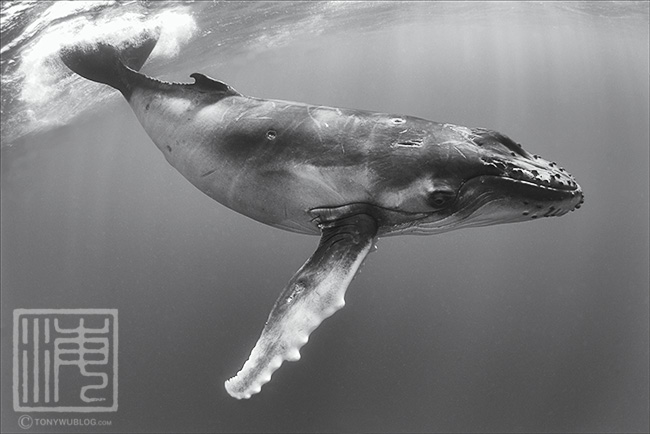
Of the 14 calves I have IDs for, eight are confirmed females vs. three definite males…an 8:3 female: male ratio. I cannot confirm sex for the remaining three.
In past seasons when I kept track of calf sex, there were consistently more females than males. While this may not necessarily mean that there actually are more female babies than males, the consistent prevalance of female over male IDs has to mean something. Just what that something is, I don’t know.
The first male calf I ID-ed this season didn’t happen until Friday, 15 August, after I had already ID-ed eight female babies. Male calf 201411 was a bit of reserved individual, sticking pretty close to mommy for the most part.
Mommy had the habit of sitting upright in the water (which, interestingly, is exactly the opposite of the mother of female calf 201404, who prefers resting upside-down in the water).
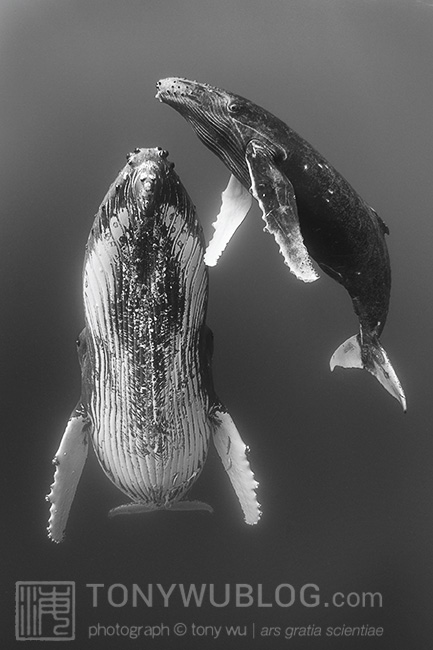
Besides the fact that calf 201411 was my first baby boy of the season, this encounter was notable for another reason…the calf’s mother has a split dorsal fin.
Split dorsals are interesting to me because they are rare, and they are easy to recognise. The last adult with a split dorsal fin that I came across was a male in 2011, and before that a humpback of indeterminate gender in 2006.
Committing easily distinguishable traits and markings to memory increases the odds that I can recognise individual whales in the future. That’s how, for example, I’ve kept track of multiple encounters (and a TV sighting) with whales like the one I’ve dubbed Super Mommy.
Incidentally, you might hear people opine that these unique dorsals are due to the whales being hit by boat props. That would be incorrect.
Split dorsal fins like this are not injuries; they are physical traits, the phenotypic expression of genotype…to get a bit sciencey.
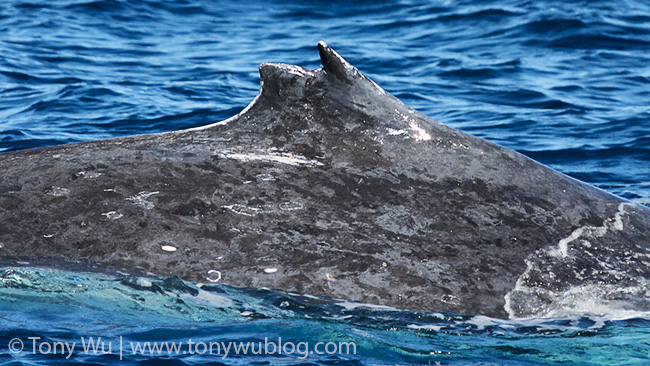
A brief word about escorts…Out of 14 total mother/ calf pairs ID-ed, only five have been accompanied by escorts. That’s significantly below the ratios during previous seasons.
My belief is that the ratio will increase as the season progresses, because the number of eligible females without babies will decrease as they mate and head out, leaving only females already with calves for the males to pursue.
It’ll be interesting to see whether this progresses as I expect, or if the whales throw another curve ball to keep me guessing.
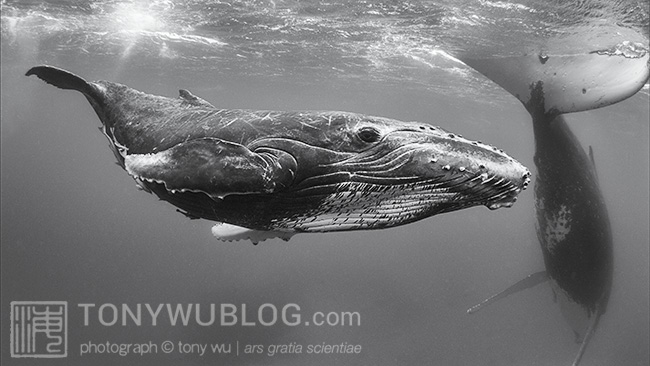
Every once in a while, there is a star mother/ calf pair…an inquisitive, interactive calf coupled with a laid-back, relaxed mother who seems content to let humans babysit…in the tradition of Ikumi 201005 and Jack 201309.
This season’s star is without a doubt calf 201404, a beautiful little girl who loves to play. Her mother has the habit of resting with her fluke up at the surface. From a distance, the whale’s ventral-side-up fluke looks somewhat like an open book, so the captains have nicknamed her The Bible.
I’ve only seen this resting pose once before (another adult female), so it’s not terribly common.
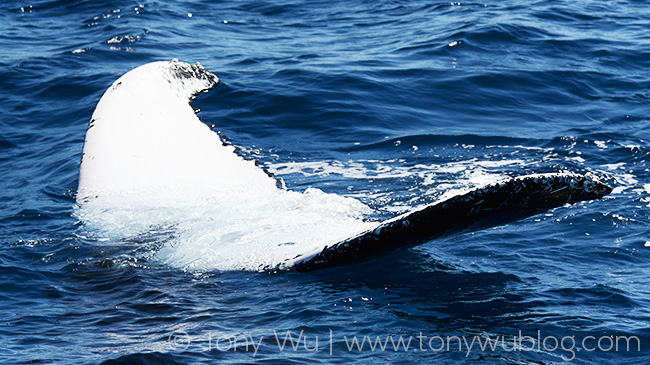
Judging from chatter among the boat captains, The Bible has been around since early August at the very least. I wish someone had recorded the date of the first encounter so I could have a more precise indication of how long this mother/ calf pair has been around, but I can confirm at least eight days from my own data.
Subjectively, The Bible and her calf are my favourite duo to date. The adult female’s pose and relaxed personality, coupled with the baby whale’s grace and curiosity…have made for rewarding encounters and some great photos (the picture at the top of this post is of calf 201404, an image I think will become one of my favourites of all time).
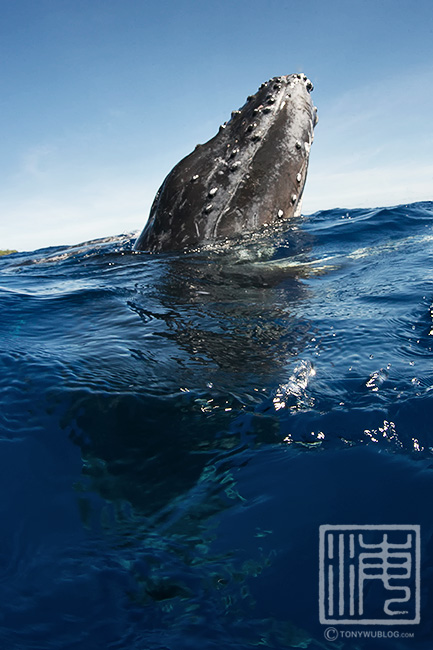
Ambient conditions: Both the air and the water temperature have continued to be colder than normal. It dropped to a brisk 15ºC (59ºF) overnight, and the water is probably 2–3ºC colder than what I’d normally expect.
It’s also been cloudy/ overcast for most of my stay so far, with breezes from the south/ southeast, though we just had a refreshing window of sunshine from mid-Wednesday through Saturday morning.
It was fortunately during this time that I witnessed for the first time three adult humpback whales breaching together. 120 tonnes or more airborne, simultaneously, is quite the spectacle!
It’s a good thing I got over my bout of whooping cough, because I was hooting and hollering for all I was worth while these whales were putting on their show.
I didn’t manage to get all three whales in a single photo, but I did capture two:
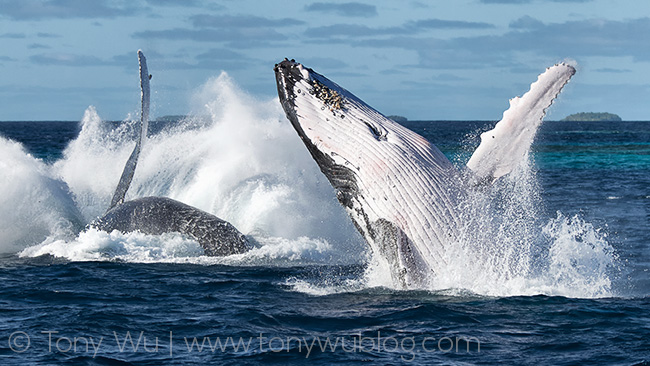
In contrast to all the happy stuff above, I have something sad to share…another humpback whale killed by a longline.
To be clear, when I took the photograph below, the whale was still alive, though its days were numbered. The visibility was terrible, skies overcast, and whale scared, so I only went in one time to take a look.
The whale was infested with whale lice; its flesh was rotting; and worst of all, the whale let out an agonising wail. It was a gut-wrenching sound I had never heard or expected to come from a humpback.
The cry was of pain, distress, suffering, mortal despair.
The whale’s piercing lament struck with the force of a harpoon and stopped me dead in the water. I struggled to make sense of the unadulterated agony.
Then the whale swam away and dived. I took the photo below and a few more, then watched as the line descended into deep water. The line just kept passing, and passing, and passing. It continued for many tens of metres after the whale had vanished into the deep, dark murk.
A day later, I heard that some people were able to relocate the whale and remove some of the trailing line, but not the part wrapped around the whale’s fluke.
A valiant effort, but from what I saw, the infection and flesh-rot appeared too far progressed for the whale to have a reasonable hope of recovery. The entangled whale was first reported in July, so it’s been a while.
This is the second humpback whale killed by a longline that I’ve photographed here. I want it to be the last, but I know that deaths due to entanglements (along with ship strikes and acoustic damage to whales) will keep increasing.
Longlines are deployed in open ocean to catch fish to sell to consumers, mostly in wealthy nations. The by-catch is tremendous though, with sea birds, turtles, sharks, dolphins, and even whales falling victim to this indiscriminate practice.
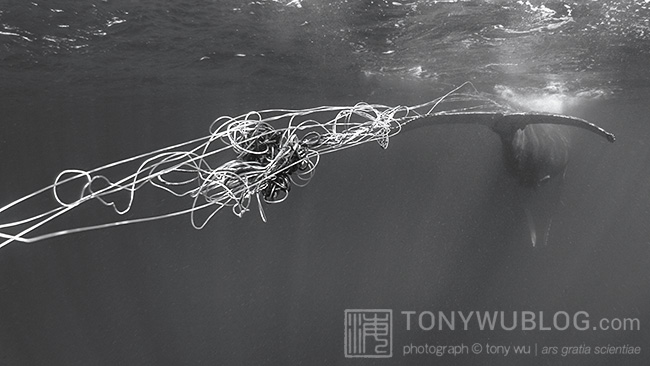
To end this post on a more upbeat note, I’d like to give a shout out to my long-time friends Charlie and Krysia, who ventured outside their comfort zone and brought their terrific kids to Tonga to experience the magic of humpback whales and the ocean/ nature in general.
Seeing the smiles on their faces, having a chance to share a few stories and laughs, imparting lifelong memories and experience…is the best incentive and reward I could possibly have.
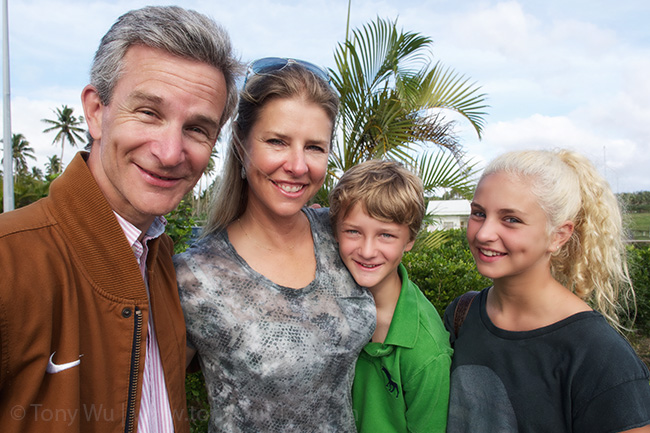
Related Posts: